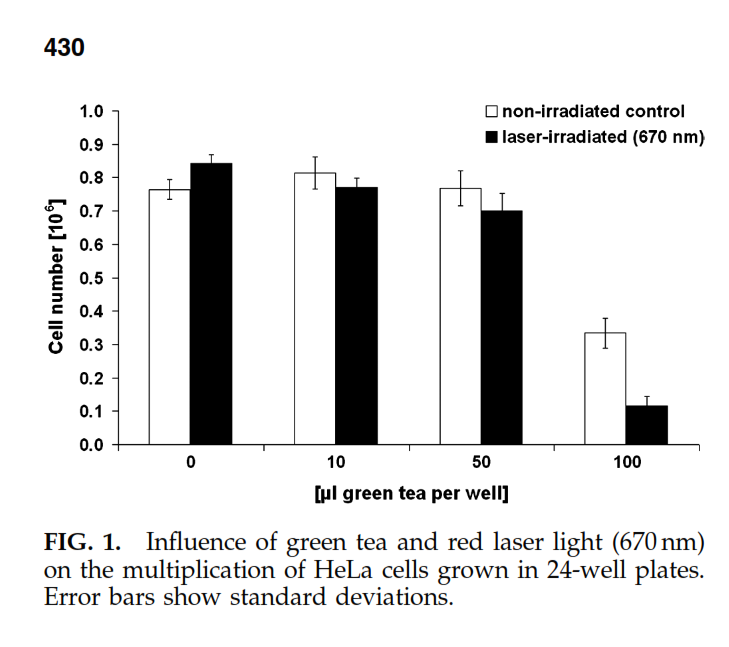The combination of topical green tea extract and red light
-
This first study shows that this combination is appears to reduce wrinkles. I consider natural sunlight in the early morning to most likely be effective as well.
Green Tea and Red Light — A Powerful Duo in Skin Rejuvenation (2009)
Objective: Juvenile skin has been the subject of intense research efforts since ancient times. This article reports on synergistic complementarities in the biological actions of green tea and red light, which inspired the design of a green tea–assisted facial rejuvenation program. Background Data: The approach is based on previous laboratory experiments providing insight into a mechanism by which visible light interacts with cells and their microenvironment. Methods: After 2 months of extreme oxidative stress, green tea–filled cotton pads were placed once per day for 20 minutes onto the skin before treatment with an array of light-emitting diodes (central wavelength 670 nm, dermal dose 4 J=cm2). Results: Rejuvenated skin, reduced wrinkle levels, and juvenile complexion, previously realized in 10 months of light treatment alone were realized in 1 month. Conclusion: The accelerated skin rejuvenation based on the interplay of the physicochemical and biological effects of light with the reactive oxygen species scavenging capacity of green tea extends the action spectrum of phototherapy. The duo opens the gate to a multitude of possible biomedical light applications and cosmetic formulas, including reversal of topical deterioration related to excess reactive oxygen species, such as graying of hair.

-
Extraordinary Anticancer Effect of Green Tea and Red Light (2010)
Objective: Increasing observational evidence suggests that epigallocatechin gallate—the major polyphenolic component of green tea—is instrumental in suppressing the growth of cancer cells. Therefore, methods that promise to enhance the suppressive potential of green tea have the highest clinical relevance. Background Data: Human cervical cancer cells, HeLa, the first continuous cancer cell line, represent a mainstay model in cancer research. Green tea inhibited their growth, whereas their exposure to moderate levels of laser light resulted in an opposite effect. Both effects are individually documented in the literature. Methods: HeLa cells were supplemented with green tea, irradiated with moderately intense laser light (670 nm) for 1 min, and incubated for 52 h. Results: We found an extraordinary inhibition of HeLa cells by a combination of green tea and red light. We achieved an inhibition of 1,460%, compared with non-irradiated samples. Conclusion: Our result receives clinical relevance from a recent study in which epigallocatechin gallate suppressed the growth of melanoma in vivo.

Free full text is here if you can access it.
-
Green Tea Catechins and Skin Health (2024)
Green tea catechins (GTCs) are a group of bioactive polyphenolic compounds found in fresh tea leaves (Camellia sinensis (L.) O. Kuntze). They have garnered significant attention due to their diverse health benefits and potential therapeutic applications, including as antioxidant and sunscreen agents. Human skin serves as the primary barrier against various external aggressors, including pathogens, pollutants, and harmful ultraviolet radiation (UVR). Skin aging is a complex biological process influenced by intrinsic factors such as genetics and hormonal changes, as well as extrinsic factors like environmental stressors, among which UVR plays a pivotal role in accelerating skin aging and contributing to various dermatological conditions. Research has demonstrated that GTCs possess potent antioxidant properties that help neutralize free radicals generated by oxidative stress. This action not only mitigates cellular damage but also supports the repair mechanisms inherent in human skin. Furthermore, GTCs exhibit anti-carcinogenic effects by inhibiting pathways involved in tumor promotion and progression. GTCs have been shown to exert anti-inflammatory effects through modulation of inflammatory signaling pathways. Chronic inflammation is known to contribute significantly to both premature aging and various dermatological diseases such as psoriasis or eczema. By regulating these pathways effectively, GTCs may alleviate symptoms associated with inflammatory conditions. GTCs can enhance wound healing processes by stimulating angiogenesis. They also facilitate DNA repair mechanisms within dermal fibroblasts exposed to damaging agents. The photoprotective properties attributed to GTCs further underscore their relevance in skincare formulations aimed at preventing sun-induced damage. Their ability to screen UV light helps shield underlying tissues from harmful rays. This review paper aims to comprehensively examine the beneficial effects of GTCs on skin health through an analysis encompassing in vivo and in vitro studies alongside insights into molecular mechanisms underpinning these effects. Such knowledge could pave the way for the development of innovative strategies focused on harnessing natural compounds like GTCs for improved skincare solutions tailored to combat environmental stresses faced by the human epidermis.
-
 L Luke referenced this topic on
L Luke referenced this topic on